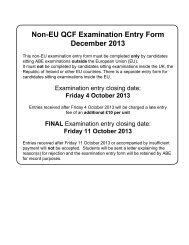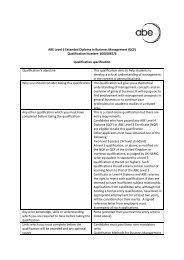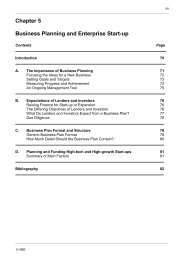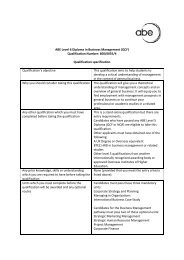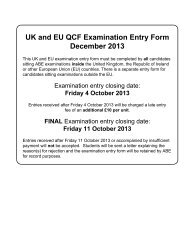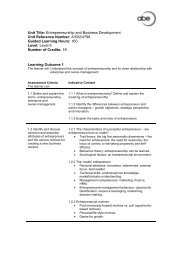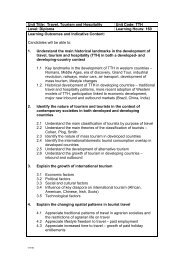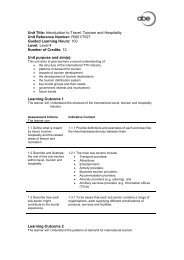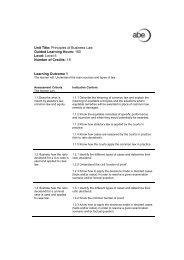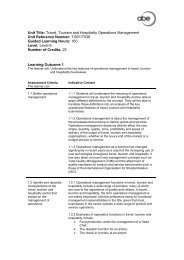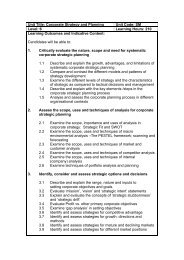Unit Title: Financial Accounting Unit Code: Acct Level: 5 Learning ...
Unit Title: Financial Accounting Unit Code: Acct Level: 5 Learning ...
Unit Title: Financial Accounting Unit Code: Acct Level: 5 Learning ...
You also want an ePaper? Increase the reach of your titles
YUMPU automatically turns print PDFs into web optimized ePapers that Google loves.
<strong>Unit</strong> <strong>Title</strong>: <strong>Financial</strong> <strong>Accounting</strong><strong>Unit</strong> <strong>Code</strong>: <strong>Acct</strong><strong>Level</strong>: 5 <strong>Learning</strong> Hours: 160<strong>Learning</strong> Outcomes and Indicative Content:Candidates will be able to:1. Understand the framework of financial accounting1.1 Describe the scope and objectives of financial accounting i.e.the provision of useful figures to people about their resources1.2 Describe the main users of accounting information and theirneeds1.3 Identify the main characteristics of useful information1.4 Explain the twelve traditional accounting concepts1.5 Explain the distinction between capital and revenue1.6 Describe the role and scope of auditing in business bothexternal and internal auditing2. Prepare and present the financial statements of limitedcompanies2.1 Describe the external publication of companies’ financialstatements2.2 Describe the elements that make up the external financialreports, e.g. the principal financial statements, the directors’report, the corporate governance report and the auditors’ report.2.3 Explain the rules contained in International Generally Accepted<strong>Accounting</strong> Principles in relation to assets, liabilities, income andexpenses2.4 Prepare income statements, balance sheets, cash flows andstatement of recognized gains and losses for limited companiesfrom a given set of information in accordance with IGAAP(Internationally Generally Accepted <strong>Accounting</strong> Practices)3. Analyse and interpret financial statements3.1 Calculate financial ratios, performance and financial status anduse them to interpret financial statements3.2 Calculate Investors ratios, explain their meaning and interpretthe results3.3 Explain limitations of ratio analysis3.4 Describe and explain the impact of changing prices on financialstatements and identify possible methods of adjusting historicalcost accounts to present more useful information to users
4. Evaluate capital structure and gearing4.1 Describe the various types of shares and loans available in themarket place to businesses4.2 Describe the issue and redemption of shares and debentures4.3 Prepare balance sheets after the issue and redemption ofshares4.4 Explain the relationship between equity and debt5. Prepare and present consolidated accounts in accordance withIGAAP5.1 Describe the concept of control in relation to a subsidiary5.2 Describe and explain principles of consolidation for a singleholding structure5.3 Describe and explain inter-company items and their eliminationfrom the consolidated accounts e.g. dividends, inter companysales, inter company loans5.4 Prepare consolidated accounts i.e. balance sheets and incomestatement for a holding company and its subsidiary both at thedate of acquisition and for subsequent periods5.5 Describe and explain the treatment of goodwill in consolidatedaccounts in accordance with IGAAP6. Identify, discuss and appraise the sources of finance available tobusinesses6.1 Describe and explain the various sources of finance available tobusinesses, long term – shareholders and financial institutions,short term- bank overdraft, short term loans, hire purchase,leasing, debt factoring, internal cash flow6.2 Explain the difference between short-term, medium-term andlong-term sources of finance6.3 Describe and explain working capital management6.4 Appraise the financing needs of a given organization
Assessment Criteria:• Assessment method: written examination• Length of examination: three hours• The examination will comprise two sections, A and B• Section A will be a compulsory question on the preparation of balancesheets• Candidates should answer three questions from a choice of seven insection B• Each question carries equal marksRecommended ReadingABE, ABE Study Manual – <strong>Accounting</strong>, ABEWood F, Sangster A, Business <strong>Accounting</strong> 2 (2005), Pearson HigherEducationISBN: 0273693107



